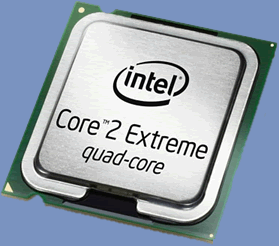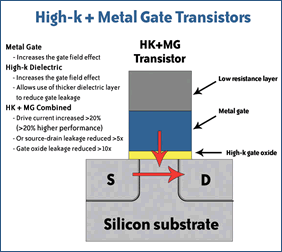Intel Core 2 Extreme QX9650 Quad Core CPU
Introduction & Specifications
Â
 Launched on the 12th November 2007 and built on a state-of-the-art 45nm manufacture process, the Intel Yorkfield series is largely a die shrink of Intel’s enormously successful 65nm Core 2 processors. With a die size of just 214mm² and 820 million transistors, Intel has performed some significant shrinking in comparison to its 286mm² / 582 million transistor predecessor, the Kentsfield
Launched on the 12th November 2007 and built on a state-of-the-art 45nm manufacture process, the Intel Yorkfield series is largely a die shrink of Intel’s enormously successful 65nm Core 2 processors. With a die size of just 214mm² and 820 million transistors, Intel has performed some significant shrinking in comparison to its 286mm² / 582 million transistor predecessor, the Kentsfield
Â
Of course, just a die shrink was never going to be enough to raise the punters eyebrows. So Intel have also given the chip a 25% increase in cache, taking it up to a rather insane 12mb (6mb per die).
Â
Also bundled on the chip are a total of 47 new SSE4 instructions designed to increase multimedia, floating point and general number crunching performance. This is further backed up by Intel’s new “Super Shuffle” engine, which Intel claim to improve the performance of both SSE2, SSE3 and SSE4 instructions that have “shuffle-like operations such as pack, unpack and wider packed shifts” resulting in further increases in performance for content creation, imaging, video and other high-performance computing.
Â
• 3.0 GHz, 1333 FSB, quad-core
• 45nm high-K metal gate transistor technology
• 12MB L2 cache
• SSE4 instructions
• 820M transistors
• Total Die Size – 214mm2
• LGA775 socket, 130W TDP, “C-stepâ€
• Overspeed protection removed
• Supported by either Intel P35 or Intel X38 chipsets
• 45nm high-K metal gate transistor technology
• 12MB L2 cache
• SSE4 instructions
• 820M transistors
• Total Die Size – 214mm2
• LGA775 socket, 130W TDP, “C-stepâ€
• Overspeed protection removed
• Supported by either Intel P35 or Intel X38 chipsets
Â
 The Yorkfield is also the first processor from Intel to use high-K: a technology engineered by Intel that replaces the polysilicon material used in transistors with a halfnium based high-K metal oxide. High-K reduces the power required to switch the flow of electrons through the transistor on and off while also reducing power leakage (flow of current outside the transistor). This reduction in power consumption has allowed Intel to maintain the same TDP (Thermal Design Power) on the QX9650 as its predecessor, the QX6850 while increasing the L2 cache memory from 8mb to 12mb.
The Yorkfield is also the first processor from Intel to use high-K: a technology engineered by Intel that replaces the polysilicon material used in transistors with a halfnium based high-K metal oxide. High-K reduces the power required to switch the flow of electrons through the transistor on and off while also reducing power leakage (flow of current outside the transistor). This reduction in power consumption has allowed Intel to maintain the same TDP (Thermal Design Power) on the QX9650 as its predecessor, the QX6850 while increasing the L2 cache memory from 8mb to 12mb.Â
As we’ve also come to expect from the “Extreme” series, Intel have removed the “Overspeed protection” from the QX9650 allowing enthusiasts to overclock the processor using only the multiplier settings in the BIOS. This combined with the Yorkfield’s support for 0.5x increments in its multiplier settings gives enthusiasts a much finer level of control over their CPU overclock, and can remove a lot of the problems often associated with overclocking via the FSB.
Â
Obviously the main reason we’re here today is to find out whether any of the technological advances and extra features found on the QX9650 actually make it any better than its 65nm predecessors. So let’s get down to business..


